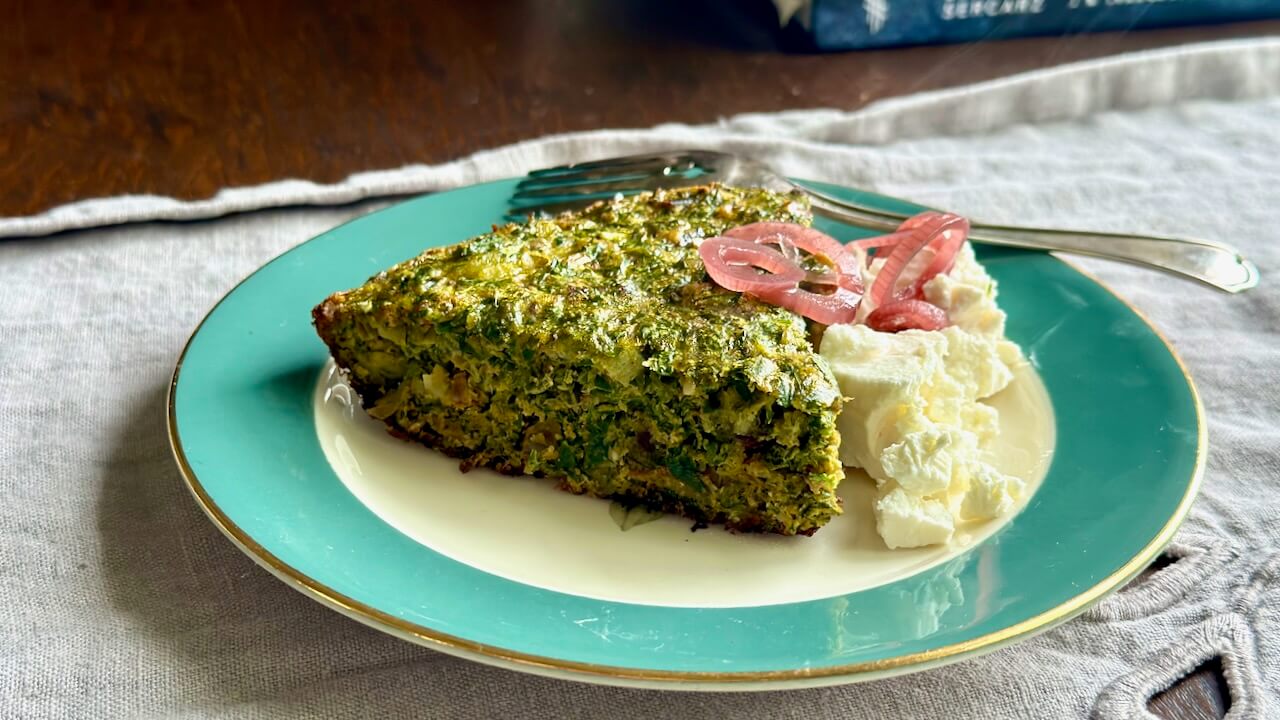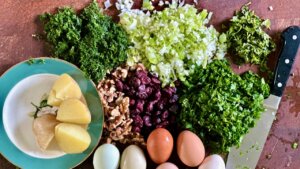These bodaciously herbaceous Jewish ingredients just might make you cuckoo for kuku
Fresh herbs are essential to a scrumptious frittata-like Persian specialty

A Shou Shou-inspired kuku. Why it’s called ‘Shou-Shou’ remains a mystery. Photo by Liza Schoenfein
While picking voluminous handfuls of basil, parsley, dill, and cilantro from my garden this summer and wondering what to do with it all, I began thinking about the role of fresh herbs in Jewish cooking — and how differently they’re deployed depending on whether the food is Ashkenazi, Sephardi, or Mizrachi (Middle Eastern) in origin.
Eastern European Jews traditionally do a lot with dill — pickles, chicken soup, borscht, cucumber salad — but the only other fresh herb that seems to pop up regularly is parsley, and that’s mainly as a garnish. (I did grow up with a fondness for mint, but that was in the form of the bright green jelly my grandmother served alongside her lamb chops.)
For Mizrachi Jews, fresh herbs are prominent — and in some cases predominant — as in the chili-and-cilantro-based condiment zhoug, which originated in Yemen and is ubiquitous in Israel, and in tabouli, which is bright green with parsley and mint when made in Lebanese kitchens, while being lighter on the herbs and heavier on the bulgar in Syrian ones.
Israelis typically enjoy hot tea made with fresh mint — only sometimes in combination with black tea — and even their frozen lemonade, called limonana, is a chartreuse-colored blend of lemon and mint. All manner of fresh herbs are incorporated into salads, sprinkled atop or stuffed within cooked vegetables, flecked throughout falafel, and mixed into soups, braises, kofta (meatballs) and kabobs.
But what about Sephardic cuisine? I was musing about this with my friend Judy, who’d invited me over for lunch. She jumped up from the table and went to her bookshelf, returning with a copy of Sephardic Israeli Cuisine: A Mediterranean Mosaic by Sheilah Kaufman. Flipping to H in the index, I found two recipes under “Herb”: “Green Soup, Egyptian,” and “Fresh Kuku, Shou Shou’s.” I was captivated by these two titles — if slightly confused by the “Sephardic” designation being used in reference to dishes that originated in Egypt and Persia.

Kaufman cleared this up quickly in a chapter called “A Brief History of the Jews and Their Wanderings.” (At this point I’m never surprised when Jewish cookbooks include better histories than many history books.) As Kaufman relays, Jews were expelled from Spain for the first time in 1391, and began making their way East toward Byzantium and the Ottoman Empire.
With the reign of Isabella and Ferdinand a century later, up to a quarter million more Jews were forced to leave the Iberian Peninsula, and many headed to Muslim countries in North Africa and what we now call the Middle East. “Because a large number of Sephardic Jews lived in the same areas as the Hamizrach,” she wrote, “they have more or less blended into those countries where they settled.”
My confusion thus validated, I studied the two recipes whose titles had caught my eye. The green herb in the Egyptian soup is called molokhia (which the author spells “melokhia”), “a member of the mallow family, which grows wild in the springtime in the Middle East,” according to Kaufman. It is sometimes referred to as jute or Jew’s mallow, and can be found frozen in Middle Eastern and other specialty markets such as Kalustyans.
Even more intriguing was Shou Shou’s Fresh Herb Kuku. I was only vaguely aware of kuku, or kuku sabzi, an herb-packed frittata-type thing that was part of a feature in The New York Times called “Chef Samin Nosrat’s 10 essential Persian Recipes.” (Sabzi means herb in Farsi.) But I had never eaten — much less made — the dish, and who, I wanted to know, was Shou Shou?
I borrowed Judy’s book, and began comparing Shou Shou’s kuku to that of other recipes I found. They all called for an abundance of fresh herbs, along with chopped walnuts and either dried barberries (sour little berries from a Persian shrub) or cranberries. Many included turmeric and/or fenugreek, and others engaged some combination of cumin, cinnamon, cardamom and nutmeg. Shou Shou’s had no spice except pepper, and was the only recipe I found that added a mashed potato to the mix.
Taking bits of inspiration from each, I created the following adaptation. Sweet and savory, with a beautiful hearty texture and emerald color, the kuku was a phenomenal way to highlight the bountiful bunches of herbs I’d picked. Salty feta and pickled red onion were excellent accompaniments.
As for Shou Shou, it turns out Kaufman didn’t know who he (or she) was. (The recipe — title and all — was contributed by someone from a Jewish food Listserv.) What we do know is that Shou Shou sure made a mean kuku.
Recipe for Shou Shou-inspired kuku

If you don’t have the exact herbs listed below or can’t stand cilantro, feel free to improvise. You can even sub in some spinach or kale.
Servings: 6
3-4 tablespoons olive oil, divided
1 cup finely chopped scallions
6 eggs
1 ½ cups chopped parsley
¾ cup chopped dill
½ cup chopped cilantro
½ cup chopped dried cranberries
½ cup chopped walnuts
1 medium potato, boiled, peeled, and mashed
1 teaspoon baking powder
½ teaspoon salt
12 grindings black pepper
½ teaspoon ground turmeric
½ teaspoon ground cinnamon
½ teaspoon ground nutmeg
¼ teaspoon ground cumin
Feta cheese
Pickled red onion for serving (with vinegar, sugar and salt; see instructions below main recipe)
- Preheat oven to 400 F.
- Heat 1-2 tablespoons of the oil in a 10-inch oven-proof skillet and sauté scallions over medium-low heat until soft and slightly golden, about 5-7 minutes. Meanwhile, beat the eggs in a medium bowl, and add the rest of the ingredients, including the scallions.
- Wipe out the pan. Heat remaining 2 tablespoons of oil in the skillet until hot but not smoking. Pour egg mixture into pan and cook on the stovetop about 2 minutes before transferring to the hot oven. Bake 20 minutes, until kuku is set in the middle.
- Wearing oven mitts, remove the skillet from the oven (remember that the handle will be scalding hot). Slice into six wedges and serve with feta cheese and pickled red onion. Kuku is equally delicious served cold or at room temperature.
Pickled Onion
1 small red onion
1 cup white or apple cider vinegar
2 teaspoons sugar
½ teaspoon salt
Slice a red onion into thin rounds. Place in a strainer and pour boiling water over them. In a glass jar, mix vinegar, sugar, and salt until sugar and salt dissolve. Add onions and press below the liquid, adding more vinegar if necessary to cover. Cover and refrigerate at least 30 minutes. The onions will turn a vibrant shade of pink.

















